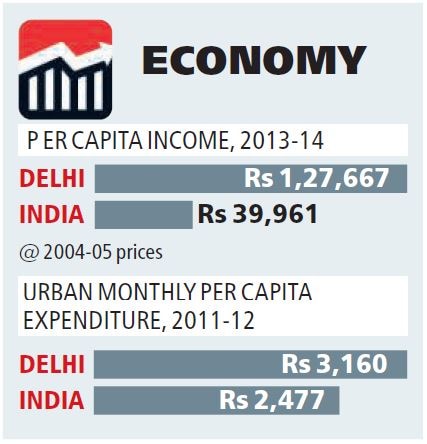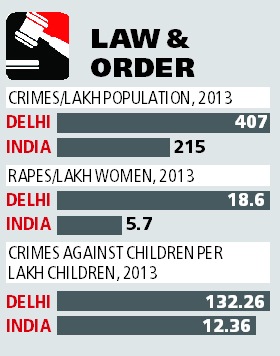Money is All City Prospers In
Swaniti Initiative | January 28, 2015 | The Swaniti Blog
Date of Release: January 28th, 2015
Published in: Indian Express
Starting today, a series that will use statistics to assess where poll-bound Delhi stands in terms of various social and development indicators, and how far government schemes and politicians have helped resolve its problems
The period before an election is a good time to look at where a state stands in terms of development — something that all parties promise to deliver if voted to power. Swaniti Initiative carried out such an analysis for Delhi, based on numbers collated from governmetn sources on its original data platform, Jigyasa.
In Delhi’s case, it is hardly surprising that it has by far the best economic indicators among all states/UTs. Delhi’s per-capita income is more than three times the national average, while its urban monthly per-capita expenditure (Rs 3,160) is also 28 per cent greater than India’s urban average
(Rs 2,477).
Low on literacy
However, as the data shows, Delhi’s real problem lies in the social sectors, which are in stark contrast with the general economic prosperity in the state. In indicators such as child sex ratio, Delhi is far below the national average. The literacy rate in urban areas of Delhi is a mere 6.4 percentage points greater than the national urban average, and much lower than in many other Indian states such as Kerala, Tamil Nadu and Mizoram.
Even in a most basic health indicator such as infant mortality rate (IMR), Delhi is the worst among the four metros. According to a recent report (‘Ending newborn deaths, ensuring every baby survives; Save the Children global report, February 2014), Delhi’s IMR of 30 between 2010 and 2012 was much higher than that of Chennai (15), Kolkata (20) and Mumbai (20). Though the latest figures show a drop in the IMR to 25, it remains higher than in the other metros.
The rapid and largely unplanned migration into Delhi in the past few years may account for Delhi’s uninspiring social sector statistics. Between 2001 and 2011, Delhi saw a 21 per cent increase in its population, but with almost no increase in housing or other urban services for a large majority of the migrant population. According to some estimates, more than half of Delhi’s population live in slums and unauthorised colonies (though notified slums recorded by the Census account for 10 per cent of the population), with poor access to urban amenities and other social services such as health and education.
High on crime
The other depressing set of social statistics in Delhi pertains to crimes. The rate of crime and rape in Delhi is more than twice the national average, while the rate of crimes against children is more than 10 times the national average.
The new government in Delhi will therefore have its task cut out. In the case of law andorder, there’s little that the state governmentcan do as long as Delhi is not granted full statehood. But on other issues such as health, education and livelihood, the state will need to improve existing services to provide access to a much wider population. For this purpose, the state government might need to expand schemes pertaining to education and health, both in terms of outlays and outcomes, particularly since a buoyant economic growth has meant that the fiscal situation of the state government remains robust.
Delhi is indeed India’s richest state in statistical terms, but as social indicators show, there is still some way to go before Delhiites achieve all-round prosperity.
This data series is published in partnership with Swaniti Inititaive.
Data sources: Jigyasa, NCRB, Census 2011, RBI Statistical Handbook, Planning Commission


